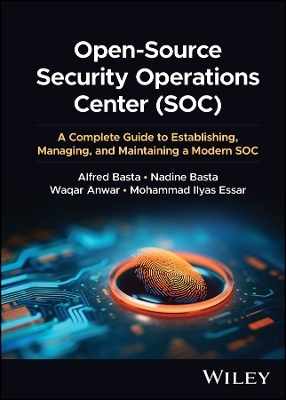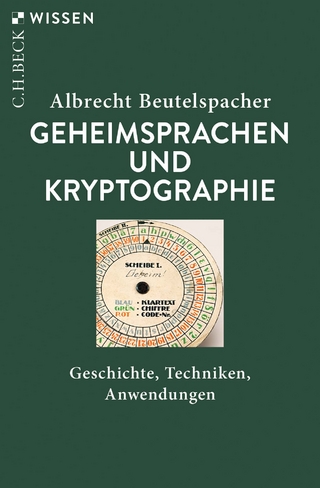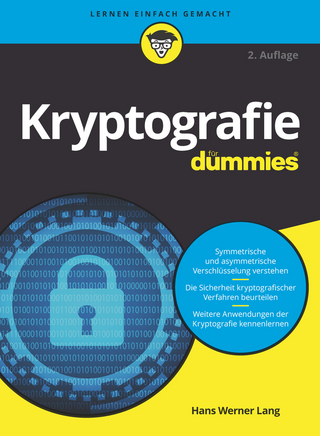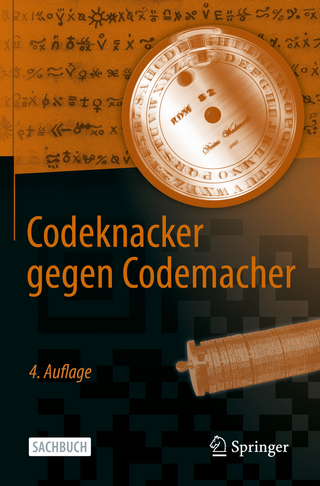
Open-Source Security Operations Center (SOC)
John Wiley & Sons Inc (Verlag)
978-1-394-20160-0 (ISBN)
In Open-Source Security Operations Center (SOC): A Complete Guide to Establishing, Managing, and Maintaining a Modern SOC, a team of veteran cybersecurity practitioners delivers a practical and hands-on discussion of how to set up and operate a security operations center (SOC) in a way that integrates and optimizes existing security procedures. You’ll explore how to implement and manage every relevant aspect of cybersecurity, from foundational infrastructure to consumer access points.
In the book, the authors explain why industry standards have become necessary and how they have evolved – and will evolve – to support the growing cybersecurity demands in this space. Readers will also find:
A modular design that facilitates use in a variety of classrooms and instructional settings
Detailed discussions of SOC tools used for threat prevention and detection, including vulnerability assessment, behavioral monitoring, and asset discovery
Hands-on exercises, case studies, and end-of-chapter questions to enable learning and retention
Perfect for cybersecurity practitioners and software engineers working in the industry, Open-Source Security Operations Center (SOC) will also prove invaluable to managers, executives, and directors who seek a better technical understanding of how to secure their networks and products.
Alfred Basta, PhD, CCP (CMMC), CISM, CPENT, LPT, OSCP, PMP, CRTO, CHPSE, CRISC, CISA, CGEIT, CASP+, CYSA+, is a professor of mathematics, cryptography, and information security as well as a professional speaker on internet security, networking, and cryptography. He is a member of many associations, including ISACA, ECE, and the Mathematical Association of America. Dr. Basta’s other publications include Pen Testing from Contract to Report, Computer Security and Penetration Testing, Mathematics for Information Technology, Linux Operations and Administration, and Database Security. In addition, Dr. Basta is the chair of EC-Council’s CPENT Scheme Committee. He has worked as a faculty member and curriculum advisor for programming and cyber security programs at numerous colleges and universities. Nadine Basta, MSc., CEH, is a professor of computer science, cybersecurity, mathematics, and information technology. Her numerous certifications include CEH, MCSE, MSDBA, CCDP, NCSE, NCTE, and CCA. A security consultant and auditor, she combines strong “in the field” experience with her academic background. She is also the author of Computer Security and Penetration Testing, Mathematics for Information Technology, and Linux Operations and Administration. Nadine has extensive teaching and research experience in computer science and cybersecurity. Waqar Anwar is a Cybersecurity Curriculum Specialist with over 10 years of experience in the field. He also develops and delivers training to faculty and staff on cybersecurity topics and conducts research on cybersecurity topics. Mr. Anwar is a frequent speaker at industry conferences. He is also a member of several cybersecurity organizations including SysAdmin, Audit, Network and Security SANS, CYBRARY, and Information Systems Security Association International ISSA. Mohammad Ilyas Essar is a Certified OSCP, CRTO, HTB CPTS, CASP+, PENTEST+, and CEH Master. He is currently employed as a Senior Cybersecurity Analyst in Canada. He is highly passionate and dedicated to the field of cybersecurity. With a solid career background in this domain, he brings five years of progressive experience spanning various domains. Ilyas specializes in Red Teaming, offensive security, and penetration testing, consistently achieving exceptional results. Ilyas is constantly driven to excel in his field, actively participating in Capture The Flag (CTF) competitions, where he dedicates a significant portion of his time to honing his skills as a Pentester and Red Teamer. He is also part of Synack Red Team, where he performs bug bounty hunting.
Preface xiii
1 Introduction to SOC Analysis 1
Overview of Security Operations Centers (SOCs) 1
Importance of SOC Analysis 1
Objectives and Scope of the Book 2
Structure of the Book 3
Challenges in SOC 4
SOC Roles and Responsibilities 6
SOC Team Structure and Roles 7
SOC Models and How to Choose 8
Choosing the Right SOC Model 10
Evaluate Where You Are 11
Define the Business Objectives 12
Designing an SOC 13
Future Trends and Developments in SOCs 15
SOC Challenges and Best Practices 16
Best Practices for SOC Management 17
Case Studies and Examples of Successful SOCs 18
References 19
2 SOC Pillars 21
Introduction 21
Definition of SOC Pillars 21
People 22
Process 23
Technology 25
Data 26
Importance of SOC Pillars in Cybersecurity 28
Levels of SOC Analysts 28
Processes 31
Event Triage and Categorization/The Cyber Kill Chain in Practice 31
Prioritization and Analysis/Know Your Network and All Its Assets 33
Remediation and Recovery 34
Assessment and Audit 34
Threat Intelligence 34
Threat Intelligence Types 35
Threat Intelligence Approaches 36
Threat Intelligence Advantages 36
References 36
3 Security Incident Response 39
The Incident Response Lifecycle 39
Incident Handling and Investigation Techniques 40
Post-incident Analysis: Learning from Experience to Strengthen Defenses 42
The Importance of Information Sharing for Effective Incident Response 44
Handling Advanced Persistent Threats and Complex Incidents 47
Communication Strategies During and After Incidents 49
Cross-functional Coordination in Incident Response 51
Leveraging Technical Key Performance Indicators 53
Navigating Incident Impacts Through Decisive Prioritization 55
Adaptive Access Governance 56
Maintaining Response Communications and Integrations 57
Incident Response in Diverse IT Environments 58
Addressing International and Jurisdictional Challenges in Incident Response 60
Mental Health and Stress Management for SOC Analysts and Incident Responders 62
Case Studies and Real-World Incident Analysis: A Crucial Practice for Enhancing Incident Response 63
Analyzing the 2021 Microsoft Exchange Server Vulnerabilities 64
References 64
4 Log and Event Analysis 67
The Role of Log and Event Analysis in SOCs 67
Advanced Log Analysis Techniques 70
Detecting Anomalies and Patterns in Event Data 71
Integrating Log Analysis with Other SOC Activities 72
Enhancing Log Data Security and Integrity 80
Reconstructing the Attack Chain 81
Leveraging APIs for Advanced Threat Detection 83
Cross-platform Log Analysis Challenges and Solutions 88
Developing Skills in Log Analysis for SOC Analysts 90
Spotting Cloud Cryptojacking 91
Integration of Log Analysis with Threat Intelligence Platforms 93
Evaluating Log Analysis Tools and Solutions 94
Addressing the Volume, Velocity, and Variety of Log Data 95
Building a Collaborative Environment for Log Analysis 96
Democratized Threat Intelligence 97
References 97
5 Network Traffic Analysis 99
Traffic Segmentation and Normalization 99
Threat Intelligence Integration 100
Contextual Protocol Analysis 103
Security Regression Testing 107
Network-based Intrusion Detection and Prevention Systems (NIDS/NIPS) 109
Vulnerability Validation 113
Impact Examination 114
Inspecting East–West Traffic 116
Analyzing Jarring Signals 122
Modeling Protocol Behaviors 125
Utilizing Flow Data for Efficient Traffic Analysis 131
Constructing an Implementation Roadmap 134
Performance Optimization Techniques for Traffic Analysis Tools 134
References 136
6 Endpoint Analysis and Threat Hunting 139
Understanding Endpoint Detection and Response Solutions 139
Techniques in Malware Analysis and Reverse Engineering 141
Data and Asset-Focused Risk Models 144
The Role of Behavioral Analytics in Endpoint Security 146
Principles for Minimizing Endpoint Attack Surfaces 149
Advanced Managed Endpoint Protection Services 154
Adapting Monitoring Strategies to Fragmented Cloud Data Visibility 156
Responding to Events at Scale 161
Case Study: Financial Services Organization 167
References 168
7 Security Information and Event Management (SIEM) 169
Fundamentals of SIEM Systems 169
Distributed Processing 172
Next-gen Use Cases 175
Accelerated Threat Hunting 176
Compliance and Regulatory Reporting with SIEM 178
Infrastructure Management 181
The Insider Threat Landscape 185
SIEM Log Retention Strategies and Best Practices 187
Automated Response and Remediation with SIEM 189
Threat Hunting with SIEM: Techniques and Tools 191
SIEM and the Integration of Threat Intelligence Feeds 193
Common SIEM Capability Considerations 197
Operational Requirements 199
Comparing Commercial SIEM Providers 202
Proof of Concept Technical Evaluations 203
References 204
8 Security Analytics and Machine Learning in SOC 207
Behavioral Analytics and UEBA (User and Entity Behavior Analytics) 209
Machine Learning Algorithms Used in Security Analytics 211
Challenges of Operationalizing Predictive Models 215
Custom Machine Learning Models Versus Pre-built Analytics 217
Optimizing SOC Processes with Orchestration Playbooks 219
Anomaly Detection Techniques and Their Applications in SOC 220
Investigative Analysis 223
Challenges in Data Normalization and Integration 225
References 228
9 Incident Response Automation and Orchestration 231
Introduction 231
Evaluating the Impact of Automation in SOCs 233
The Role of Playbooks in Incident Response Automation 235
Threat-Specific Versus Generic Playbooks 237
Automated Threat Intelligence Gathering and Application 240
Automating Collection from Diverse Sources 241
Measuring the Efficiency and Effectiveness of Automated Systems 245
Critical Success Factors for High-Performance SOCs 246
Improving SOC Performance 247
Centralizing Cloud Data and Tooling 251
Maintaining Compliance Through Automated Assurance 253
Injecting Human-Centered Governance 255
References 256
10 SOC Metrics and Performance Measurement 259
Introduction 259
Core Areas for SOC Metrics 259
Advancing Cyber Resilience with Insights 261
Performance Measurement 265
Utilizing Automation for Real-Time Metrics Tracking 266
Anomaly Detection 267
Integrating Customer Feedback into Performance Measurement 268
Metrics for Evaluating Incident Response Effectiveness 270
Assessing SOC Team Well-being and Workload Balance 271
Skills Investment Gap Assessment 272
Financial Metrics for Evaluating SOC Cost Efficiency and Value 274
Metrics for Measuring Compliance and Regulatory Alignment 276
Artificial Intelligence and Machine Learning 279
Strategies for Addressing Common SOC Performance Challenges 280
Future Trends in SOC Metrics and Performance Evaluation 289
Unifying Metrics for Holistic SOC Insights 292
References 292
11 Compliance and Regulatory Considerations in SOC 295
Introduction 295
Regulatory Challenges Across Geographies 297
Just-in-Time Security Orchestration 298
Managing Incident Responses in a Regulatory Environment 303
Healthcare Data Breaches 305
Financial Services Data Security 306
Energy and Utility Incident Response 306
Future Trajectories 307
Continuous Incident Readiness Assessments 307
Integrating Compliance Requirements into SOC Policies and Procedures 308
Unified GRC Dashboard Visibility 310
Open Banking Third-Party Risk Mitigations 311
The Role of SIEM in Achieving and Demonstrating Compliance 313
Emerging Technology Compliance Gap Forecasting 316
Crown Jewels Risk Assessments 319
Navigating International Compliance and Data Sovereignty Laws 321
The Impact of Emerging Regulations 322
Case Studies: SOC Adaptations 323
NIS Directive Response Planning 324
References 326
12 Cloud Security and SOC Operations 327
Introduction 327
Cloud Access Security Brokers (CASBs) Integration with SOC 330
Continuous Compliance Monitoring 332
Container Sandboxing 334
Compliance Validation and Drift Detection 336
Centralizing IAM Across Hybrid and Multicloud Deployments 337
Data and Key Management for Encryption 339
Preserving Recoverability and Governance 340
Securing Multicloud and Hybrid Cloud Environments 342
Establishing a Root of Trust Across Fragmented Cloud Key Infrastructures 343
Mapping Dependency Context Across Managed Cloud Services 345
Best Practices for Cloud Incident Response Planning 347
Remediating Drift through Policy as Code Frameworks 349
The Role of APIs in Cloud Security and SOC Operations 352
Applying Machine Learning Models to API Data 353
Innovating Detection and Response Capabilities Purpose Built for Cloud 355
Future Trends in Cloud Security and Implications for SOCs 358
References 359
13 Threat Intelligence and Advanced Threat Hunting 361
Advanced Threat-hunting Methodologies 364
Lifecycle Intelligence for Automated Response 366
Operationalizing Threat Intelligence for Proactive Defense 368
The Importance of Context in Actionable Threat Intelligence 370
Threat Intelligence Sharing Platforms and Alliances 372
Estimating Campaign Impacts Optimizing Investment Prioritization 375
Applying Generative Analytics for Incident Discovery 377
Techniques for Effective Threat Hunting in the Cloud 379
Behavioral Analytics for Detecting Insider Threats 382
Developing Skills and Competencies in Threat Hunting 384
Codify Analytic Techniques Targeting Specific IoCs 388
Case Studies: Successful Threat Intelligence and Hunting Operations 390
References 393
14 Emerging Trends and the Future of SOC Analysis 395
Introduction 395
Emerging Trends and the Future of SOC Analysis 395
The Impact of Cloud Security on SOC Operations 397
Predicting Future Directions in SOC Analysis 398
The Rise of Security Orchestration, Automation, and Response (SOAR) 400
Blockchain Technology for Enhanced Security Measures 403
Zero-trust Security Model and SOC Adaptation 406
Enhancing SOC Capabilities with Augmented and Virtual Reality 407
The Impact of 5G Technology on Cybersecurity Practices 408
Post-Quantum Cryptography 411
Financial Sector Complexity 414
Anatomy of Modern APTs 414
Deception Techniques 416
The Future Role of Human Analysts in Increasingly Automated SOCs 417
Tiered Analyst Workforce 418
References 419
15 Cybersecurity Awareness and Training in SOC Operations 421
Designing Effective Cybersecurity Training Programs for SOC Teams 423
Role of Continuous Education in Enhancing SOC Capabilities 425
Case Studies: Impact of Training on Incident Response and Management 426
Implementing Continuous Feedback Loops 428
The Evolving Role of SOCs 431
Gamification for Engagement 433
The Impact of Remote Work on Cybersecurity Training and Awareness 437
Future Trends in Cybersecurity Training and Awareness for SOCs 439
References 441
Index 443
| Erscheinungsdatum | 25.09.2024 |
|---|---|
| Verlagsort | New York |
| Sprache | englisch |
| Themenwelt | Mathematik / Informatik ► Informatik ► Netzwerke |
| Informatik ► Theorie / Studium ► Kryptologie | |
| ISBN-10 | 1-394-20160-5 / 1394201605 |
| ISBN-13 | 978-1-394-20160-0 / 9781394201600 |
| Zustand | Neuware |
| Haben Sie eine Frage zum Produkt? |
aus dem Bereich


